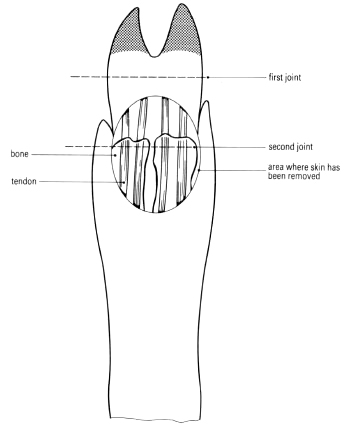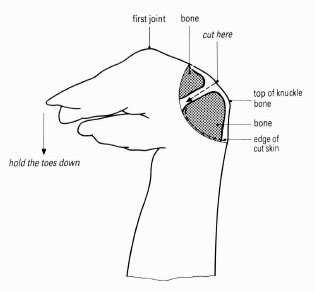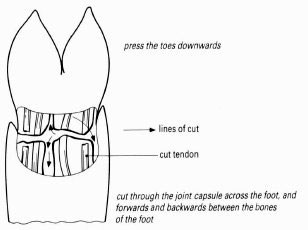Structure of synovial joint with tendons and ligaments
Class practical
This is, by many teacher accounts, a fascinating dissection using material available from a butcher. The trotter is easy to handle and provides a clear example of a synovial joint as well as the different tissues involved in joints – tendons, ligaments, cartilage, bone and muscle.
Lesson organisation
This could be a demonstration or an opportunity for small groups to work on dissection depending on the availability of source material, or suitable dissecting tools.
Apparatus and Chemicals
For each group of students:
Pig's trotter, 1
Dissection kit, 1 for each group
For the class – set up by technician/ teacher:
Soap and paper towels for handwashing
Bowl or bag to collect dissected material
Health & Safety and Technical notes
Sensible hygiene precautions should be taken as for handling raw meat in the kitchen – ensure students wash their hands thoroughly after the dissection.
The tools required for dissection must be sharp to enable effective work – so need to be handled with care and with teachers prepared with appropriate first aid for any cuts that occur.
1 Small, tender trotters may be easier to dissect.
2 Blanching the trotters for a minute or two in boiling water may reduce the numbers of bacteria on the meat surface, and make the tissues softer for dissection.
3 If there is only one trotter available for dissection, try to set up a video camera and projector so that everyone gets a good view.
Ethical issues
The animal material used has not been produced for the purpose of the investigation – it is a regular by-product of the meat industry, available for consumption from some butchers, or part of the waste stream if not used for dissection.
Some students may be sensitive to the use of any animal product in this way, or to the very existence of animals bred and raised for human consumption.
Some students may have religious objections to handling dead animal material, particularly pigs, depending on the method of slaughter.
Procedure
SAFETY: Take care with sharp dissecting tools.
Observe careful hygiene precautions after the dissection.
Preparation
a Purchase trotters from a reliable butcher – ordering in advance and discussing how they will be used.
b Ensure all dissecting tools are clean and sharp.
c Decide how the trotters are to be disposed of.
d Ensure first aid kit for cuts is available in the teaching room.
Investigation
e Hold the trotter so that you are looking at the side of it with the toes at the bottom.
f Waggle the toes from left to right. You will see that there is a joint near the base of each toe. Each joint has a "bump" on the top.
g Now turn the trotter the other way up and bend the toes downwards. You will now see a second joint further away from the toe, rather like your knuckle.
h With a scalpel, cut vertically down the "front" surface of the trotter from 5 cm above the second joint to 5 cm below it. Take care! You will need to cut about 1 mm deep.
i Now cut from left to right directly over the joint, at right angles to the first cut. You will have a cross-shaped incision.
j Peel the skin back, using your scalpel and a pair of forceps. Cut it off, so that you have a roughly circular area with the skin removed. The skin may be quite tough, so take care not to cut yourself.
k Over the top of the joint you will see four white, tough tendons running down the foot.

l Now bend the toes down so that you can see the exposed knuckle easily.

m Cut across the knuckle horizontally, carefully cutting through the tendons and the other tissue. Underneath the tendons, close to the bone, you will find a membrane which is a little loose, behind which there is a fluid.
n Cut through the membrane and notice the fluid dribbling out. There will not be much of it. This is synovial fluid. Make sure you are bending the trotter at the joint - it makes the dissection easier.

o Cut towards the toes with a pair of scissors. You will expose the shiny white surface on the lower part of the joint.
p Cut sideways as well, cutting through the joint capsule and the ligaments which hold the bone together.
q You can now see the articulating surfaces of the joint. These are covered in cartilage. Press your scalpel into the white cartilage.
r Now slice off a small piece of cartilage. You will find pink bone underneath.
s If there is time, investigate the differences in texture between muscle,
cartilage, bone, tendon and membranes.
t Wash hands thoroughly.
Teaching notes
Have an alternative text-based activity on joints available for students who really don’t want to participate. If possible, allow them to stay in the room so they have the option to change their minds.
Ask the students to think about how the differences in structure of cartilage, bone, tendon and ligament may be related to their functions.
Explore the movement of the two cartilage covered articulating surfaces in the joint. Ask the students to think about how this movement is different if the cartilage is damaged or if the joint were arthritic.
Think about what would happen if two bones rubbed against one another, and what the synovial fluid does.
Explore confidently any feelings the students have about this kind of activity and compare what they remember next week with what they knew about joints before. How memorable will this experience be and how much has it helped them to understand the subject?
Health and safety checked, September 2008
Web links
http://www.beep.ac.uk/content/425.0.html
This is the Animal Ethics section of the Bioethics Education Project (BEEP) website. Although it doesn’t tackle dissection of animal material from food-processing sources directly, it might help you to develop a debate about using animal material in this way.
(Website accessed October 2011)


